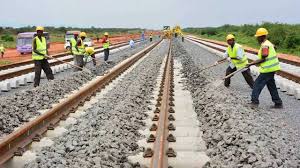

Robust Legal Framework or Hidden Obstacles? Navigating Railway and Transit Construction Laws in Nigeria
Introduction
The development of railway and transit infrastructure in Nigeria is pivotal for transforming the nation’s transportation network, boosting economic growth, and enhancing connectivity across regions. As Nigeria embarks on ambitious projects to expand and modernize its railway and transit systems, understanding the legal framework governing these constructions becomes crucial. This article delves into the legal framework for railway and transit construction in Nigeria, exploring regulatory requirements, compliance issues, and strategic approaches to navigating the legal landscape effectively.
The landscape of infrastructure development in Nigeria is evolving, with railway and transit construction emerging as focal points of national development. As the nation battles with the economic implications of congested roads, rising transport costs, and inefficient logistics chains, attention has shifted to railways as a viable and sustainable alternative.
However, the journey toward transforming Nigeria into a country with a modern and functional railway network is intricately linked to the existing legal and regulatory framework that governs railway and transit construction. The legal framework for railway and transit construction in Nigeria is multifaceted, drawing from legislation that dates back to the colonial era, constitutional provisions, environmental regulations, land use statutes, and various public-private partnership policies. All of these legal tools, while critical to project implementation, can also act as impediments when not properly harmonized or when left outdated in the face of modern infrastructural demands.
Nigeria’s railway history began under British colonial rule, and most of its major railway lines were constructed to serve economic extraction purposes. The legacy of that era still lingers, particularly through the Railway Act of 1955, which remains the primary legislation governing railway operations in Nigeria.
This Act vests ownership and operational control of all railways in the hands of the federal government. At the time of enactment, such centralization might have been efficient; however, in today’s context where decentralization, competitive federalism, and private investment are paramount to infrastructure expansion, the Act has become an obstacle to progress.
The federal exclusivity over railways is further entrenched in the Nigerian Constitution, which lists railways under the Exclusive Legislative List. This has created legal and practical challenges for state governments and private sector players seeking to invest in or manage railway infrastructure. For instance, a state government desiring to construct an intra-state rail line must first seek federal approval, a process often riddled with bureaucratic delays and political considerations.
Beyond constitutional constraints, other pieces of legislation and regulatory requirements must be navigated for any railway or transit project to take off. The Land Use Act of 1978 dictates how land can be acquired for public purposes, including infrastructure. This often leads to complicated legal negotiations and compensation disputes with landowners.
Similarly, the Environmental Impact Assessment (EIA) Act mandates that any large-scale construction project, including rail lines, must undergo rigorous environmental evaluation before implementation. While this is a commendable effort to ensure sustainability, the procedural delays and administrative red tape associated with EIA compliance can hinder project timelines.
Furthermore, laws like the Infrastructure Concession Regulatory Commission (ICRC) Act and the Public Procurement Act establish the rules of engagement for public-private partnerships and the awarding of contracts, respectively. These laws, although designed to enhance transparency and accountability, often create procedural rigidity that frustrates innovation and agility, especially in fast-paced infrastructure projects.
Institutionally, Nigeria’s railway and transit landscape is regulated by several entities whose mandates sometimes overlap, creating a legal and operational maze. The Nigerian Railway Corporation (NRC) is the primary entity empowered by law to construct, manage, and operate rail lines. However, the NRC has been criticized for lacking the institutional capacity and funding to effectively execute large-scale projects. Meanwhile, the Federal Ministry of Transportation plays a policy oversight role, coordinating with state transport ministries and international partners.
There are also contributions from entities like the Infrastructure Concession Regulatory Commission and various legal advisers involved in structuring PPP agreements. The result is often a duplication of roles and conflicting regulations that complicate project delivery.
The need for a more streamlined and contemporary legal framework is thus undeniable. For Nigeria to realize its railway ambitions, it must first confront the limitations of its current legal environment. This involves legislative reform, particularly of the Railway Act and relevant constitutional provisions.
It also entails improved coordination among institutional actors, enhancement of legal protections for private investors, and a regulatory approach that supports, rather than stifles, innovation. The current legal architecture has served its historical purpose, but as Nigeria seeks to align with global standards and respond to the complex demands of urbanization and industrialization, there is a pressing need for reform. A modern legal framework should provide clarity, reduce bureaucratic burdens, and ensure that both public and private stakeholders can invest in rail infrastructure with confidence and legal certainty.
Understanding the Significance of Railway and Transit Infrastructure
1. Economic Development and Connectivity
– Overview:
Railway and transit infrastructure plays a critical role in facilitating the movement of goods and people, reducing transportation costs, and stimulating economic activity.
– Impact:
Efficient rail and transit systems enhance regional connectivity, promote trade, and support economic development by linking urban centers with rural areas.
2. Urbanization and Sustainable Transportation
– Overview:
As Nigeria continues to urbanize, there is a growing need for sustainable transportation solutions to manage increasing traffic and reduce congestion.
– Impact:
Developing robust rail and transit systems contributes to sustainable urban mobility, reduces traffic congestion, and minimizes environmental impact by promoting public transportation.
3. Job Creation and Investment
– Overview:
Railway and transit construction projects generate significant employment opportunities and attract investment from both domestic and international sources.
– Impact:
These projects create jobs in construction, operations, and maintenance, while also stimulating investment in related sectors such as manufacturing and technology.
Key Components of the Legal Framework for Railway and Transit Construction
1. Legislative Framework
– Overview:
The legislative framework for railway and transit construction in Nigeria consists of various laws, regulations, and policies that govern the planning, development, and operation of transportation infrastructure.
– Key Legislation:
Railway Act: The Railway Act provides the legal basis for the establishment, regulation, and operation of railway services in Nigeria. It outlines the roles and responsibilities of the Nigerian Railway Corporation (NRC) and other stakeholders.
Transit Law: The Transit Law governs the planning, construction, and management of public transit systems, including bus rapid transit (BRT) and light rail systems.
2. Regulatory Agencies and Authorities
– Overview:
Several regulatory agencies and authorities are responsible for overseeing railway and transit construction projects, ensuring compliance with legal and safety standards.
– Key Agencies:
- Nigerian Railway Corporation (NRC): The NRC oversees the operation and development of railway infrastructure, including compliance with safety and operational standards.
- Federal Ministry of Transportation: The ministry is responsible for policy formulation, planning, and coordination of transportation infrastructure projects.
- National Environmental Standards and Regulations Enforcement Agency (NESREA): NESREA ensures that construction projects comply with environmental regulations and standards.
3. Land Acquisition and Right-of-Way
– Overview:
Acquiring land and securing right-of-way are critical aspects of railway and transit construction, often involving complex legal and administrative processes.
– Legal Considerations:
- Land Use Act: The Land Use Act governs land ownership and use in Nigeria, centralizing land control under state governors and outlining procedures for land acquisition and compensation.
- Right-of-Way Regulations: Specific regulations govern the acquisition of right-of-way for railway and transit projects, including compensation for affected landowners and environmental impact considerations.
4. Environmental Impact Assessment (EIA)
– Overview:
Environmental Impact Assessment (EIA) is a mandatory process for evaluating the potential environmental impacts of railway and transit construction projects.
– Legal Considerations:
EIA Act: The Environmental Impact Assessment Act requires that projects undergo EIA to assess potential impacts on the environment and implement mitigation measures.
– Strategy:
Conduct thorough EIA to identify and address environmental concerns such as land degradation, noise pollution, and ecological impact. Develop an environmental management plan to ensure compliance with environmental regulations.
5. Public Procurement and Contract Management
– Overview:
The procurement and management of contracts for railway and transit construction projects are governed by public procurement regulations to ensure transparency and fairness.
– Legal Considerations:
Public Procurement Act: This Act regulates procurement processes for government contracts, including bidding, contract awards, and project management.
– Strategy:
Follow the Public Procurement Act’s guidelines for competitive bidding and contract management. Develop clear and comprehensive contractual agreements that outline project scope, responsibilities, and dispute resolution mechanisms.
6. Safety and Operational Standards
– Overview:
Ensuring safety and adherence to operational standards is crucial for the successful operation of railway and transit systems.
– Legal Considerations:
Safety Regulations: Adhere to safety regulations and standards set by relevant authorities, including those related to construction, operations, and maintenance of railway and transit infrastructure.
– Strategy:
Implement comprehensive safety protocols, including worker training, safety equipment, and emergency response plans. Regularly inspect and maintain infrastructure to ensure compliance with safety standards.
Strategies for Navigating the Legal Framework
1. Engage with Legal and Regulatory Experts
– Strategic Engagement:
Collaborate with legal and regulatory experts to navigate the complexities of land acquisition, environmental assessments, and compliance requirements.
– Documentation:
Prepare and submit all necessary documentation, including land acquisition records, environmental impact assessments, and building permits, to ensure regulatory compliance.
2. Develop Comprehensive Project Plans
– Planning:
Develop detailed project plans that address legal and regulatory requirements, including safety standards, environmental management, and procurement processes.
– Implementation:
Ensure that project plans are executed according to legal and regulatory guidelines, with regular reviews and updates as needed.
3. Promote Public-Private Partnerships (PPPs)
– Overview:
Public-private partnerships (PPPs) can provide additional funding and expertise for railway and transit projects.
– Implementation:
Develop PPP models that align with project goals and local conditions. Encourage private sector investment in railway and transit infrastructure and foster collaborative efforts between government, businesses, and communities.
4. Foster Stakeholder Engagement
– Engagement:
Engage with stakeholders, including local communities, businesses, and government authorities, to address concerns and gather input.
– Communication:
Maintain open and transparent communication with stakeholders to build trust and ensure that projects align with community needs and expectations.
5. Implement Risk Management Strategies
– Risk Management:
Develop and implement risk management strategies to address potential legal, environmental, and safety risks associated with railway and transit projects.
– Mitigation:
Identify and mitigate risks through proactive planning, regular inspections, and adherence to legal and regulatory standards.
Case Studies: Successful Railway and Transit Projects in Nigeria
1. The Abuja-Kaduna Railway Project
– Overview:
The Abuja-Kaduna Railway Project involved the construction of a modern railway line connecting Abuja and Kaduna, aimed at improving transportation efficiency and connectivity.
– Outcome:
The project successfully enhanced transportation between the two cities, reducing travel time and boosting economic activity. It demonstrated effective navigation of legal and regulatory requirements, including land acquisition and safety standards.
2. The Lagos Blue Line Light Rail Project
– Overview:
The Lagos Blue Line Light Rail Project is a major transit infrastructure initiative designed to alleviate traffic congestion and improve public transportation in Lagos.
– Outcome:
The project has made significant progress in improving urban mobility, with successful implementation of public procurement processes and compliance with safety and environmental regulations.
Conclusion
Navigating the legal framework for railway and transit construction in Nigeria involves understanding and addressing various regulatory, compliance, and operational challenges. By comprehending key components such as legislative requirements, regulatory agencies, land acquisition processes, and safety standards, stakeholders can effectively manage the complexities of transportation infrastructure projects.
Implementing strategies such as engaging with legal experts, developing comprehensive project plans, promoting public-private partnerships, and fostering stakeholder engagement will contribute to the successful development of railway and transit infrastructure. As Nigeria continues to invest in its transportation network, addressing legal issues proactively will play a crucial role in achieving sustainable and impactful development across the country. By leveraging these insights and strategies, stakeholders can navigate the legal landscape of railway and transit construction, ensuring successful project outcomes and contributing to the advancement of Nigeria’s transportation infrastructure.
As Nigeria stands at the crossroads of infrastructure modernization, the importance of a well-defined and adaptable legal framework for railway and transit construction cannot be overstated. The country’s rail sector, long characterized by underinvestment and neglect, is finally beginning to receive the attention it deserves. However, the success of railway revitalization efforts depends not only on political will and financial investment but also on the legal infrastructure that supports or obstructs these ambitions. In its current form, the legal framework presents a mix of outdated laws, centralized control mechanisms, and regulatory inefficiencies that often act as roadblocks to progress.
While the Railway Act of 1955 provided a foundation for the sector, its relevance in today’s rapidly changing infrastructure environment is limited. The Act’s federal monopoly over railway development does not reflect the growing role of state governments, private investors, and multilateral stakeholders in national infrastructure development.
One of the most pressing issues that must be addressed is the concentration of legislative power over railways in the federal government. This centralized control prevents state governments from independently developing rail systems within their territories, even where such systems are necessary to address pressing urban transportation needs. As a result, states like Lagos that have embarked on ambitious transit projects often do so in legal grey areas, with risks of regulatory conflict and implementation delays.
Amending the Constitution to place railways on the Concurrent Legislative List would empower states and create a competitive environment that promotes innovation, efficiency, and local ownership of transit solutions. Moreover, a constitutional amendment would send a strong signal to potential investors that Nigeria is committed to legal reform and infrastructure decentralization.
Beyond constitutional reform, the legal framework for railway construction must embrace modern principles of sustainability, equity, and investor protection. Environmental impact assessments, land use policies, and procurement laws should be revised to strike a balance between regulatory compliance and project efficiency. These laws must also incorporate provisions for social impact assessments, displacement mitigation, and stakeholder engagement. Rail construction, particularly in densely populated or environmentally sensitive areas, affects communities in profound ways.
A people-centered legal approach that anticipates these effects and provides remedies can reduce opposition and enhance project success. Equally important is the need for laws that facilitate rather than frustrate public-private partnerships. Clear legal templates for concession agreements, dispute resolution mechanisms, and financial guarantees are essential to attract private capital. Legal certainty, especially in contract enforcement, will help Nigeria compete favorably with other emerging markets vying for infrastructure investment.
Institutional reform must accompany legal reform. Streamlining the functions of the Nigerian Railway Corporation, the Federal Ministry of Transportation, and other regulatory bodies is essential to eliminate overlapping responsibilities and ensure accountability.
A coordinated regulatory approach with one-stop legal and administrative processes for project approval, compliance, and monitoring would significantly improve turnaround times for railway projects. Such an approach would also reduce opportunities for corruption, one of the major concerns among foreign investors and development finance institutions.
The courts also have a role to play in this transformation. As more railway and transit projects emerge, legal disputes are likely to increase, particularly in areas of land acquisition, compensation, contract performance, and environmental compliance. The judiciary must be empowered through continuous training and institutional support to handle such disputes efficiently and fairly.
Landmark judicial pronouncements can also serve as legal precedents that clarify ambiguous aspects of the law and guide future infrastructural contracts. Legal practitioners, policymakers, and academics must therefore continue to advocate for proactive jurisprudence that aligns legal interpretation with developmental priorities.
In conclusion, the pathway to building a robust and efficient railway and transit system in Nigeria lies in rethinking and redesigning the legal framework that governs it. Outdated laws must give way to responsive legal instruments that reflect the realities of modern infrastructure development. Centralization must be replaced with cooperative federalism.
Legal uncertainty must be addressed with clarity and consistency. The rule of law must become a tool for empowerment, not a source of delay. A well-structured legal framework will not only unlock the potential of Nigeria’s rail sector but also elevate the country’s standing in global infrastructure indices. The stakes are high, but so are the opportunities. With the right legal reforms, Nigeria can lay down the tracks for a more mobile, connected, and economically vibrant future.
· Railway Construction in Nigeria
· Transit Infrastructure Development
· Nigerian Railway Act
· Land Acquisition for Railways
· Environmental Impact Assessment (EIA)
· Public Procurement Act Nigeria
· Nigerian Railway Corporation (NRC)
· Right-of-Way Regulations
· Safety Standards in Railway Construction
· Public-Private Partnerships (PPP)
· Sustainable Urban Mobility
· Legal Compliance in Infrastructure Projects
Contact Us
Chaman Law Firm today. Our offices are conveniently located in Lagos, FCT Abuja, Ogun State, and the UK. We are readily available to assist you with your legal needs. Whether you require consultation, representation, or ongoing legal support, Chaman Law Firm is your trusted partner.
Call us at 08065553671 or email us at info@chamanlawfirm.com to schedule a consultation.


